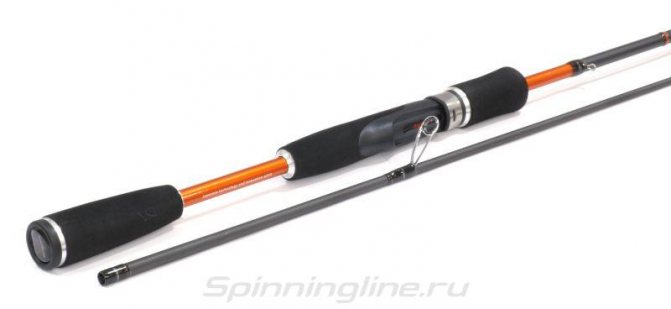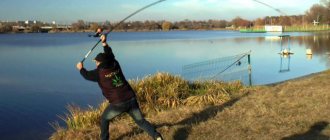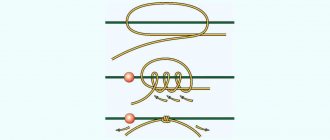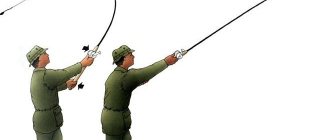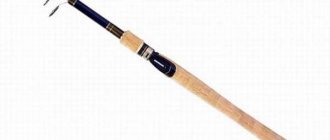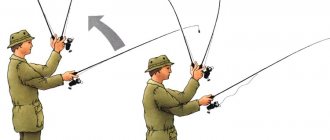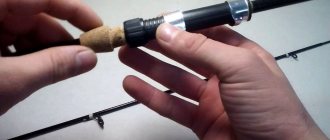- home
- Ratings
Ratings
21.10.2020120
- 5 ZETRIX AZURA AZS-702MH
- 4 MAXIMUS ENCORE MSE24L
- 3 BLACK HOLE SPIRIT S 260 7-28
- 2 SHIMANO SCIMITAR BX 90
- 1 GRAPHITELEADER ASPRO GAPS 792H
The best spinning rods for twitching
- 5 SALMO ELITE X TWITCH 15 1.80
- 4 NORSTREAM ROOKY RKS-602ML
- 3 ST.CROIX LEGEND TOURNAMENT LTES66ULF2
- 2 Black Hole Bassmania S-752M
- 1 Norstream Dynamic F1 762M
The best ultralight spinning rods
- 5 MAJOR CRAFT CROSTAGE CRX-S792UL
- 4 FAVORITE BLUE BIRD BB16-682SUL-S
- 3 SHIMANO CARDIFF 56UL
- 2 BLACK HOLE SPY S-190
- 1 MAXIMUS EGOIST-X MSEX602UL
The best budget universal spinning rods
- 3 SHIMANO VENGEANCE BX 24MH
- 2 SALMO SNIPER ULTRA SPIN 25 2.10
- 1 BLACK HOLE OPIRUS II 230 6-25
The desire to hunt and fight prey is inherited by man from his ancestors. Perhaps this is why active types of spinning fishing are so popular. This gambling activity captivates men and women; sport fishing competitions are held at international level.
The idea of a spinning rod is to track down fish, arouse interest in the predator, captivate them with the game of bait, and then win in a fair fight. Hundreds of types of baits and dozens of techniques have been invented for this purpose.
There is no one rod for all fishing methods, so they are divided according to fishing methods:
- Jig - a bait in the shape of a small fish with a weight in the front part is moved along the bottom with jerky movements, as if in a “jig” dance.
- Twitching is a jerking technique of driving a wobbler that imitates the movements of a wounded fish. It is used at any depth, successfully attracting even well-fed predators.
- Classic types of wiring - uniform, stepped, active Stop&Go.
Also, when choosing a spinning rod, you should consider the length of the stick. A three-meter rod can cast bait 100 meters, but it will be impossible to turn around in a boat. A short light spinning rod will fit into the trunk, but will not reach the middle of the pond; only young perch will bite on it.
The following materials are used for fishing rods:
- Fiberglass is strong, but heavy, your hand will get tired quickly;
- Carbon composites will be lighter, but may break under stress;
- Carbon fiber – the best spinning rods are made of it.
The next important parameter of a spinning rod is called a test, measured in grams and determines the weight of the bait to which the rod is “tuned” and with which it works best. According to the test, they can be of the following class:
- Ultra-light (test up to 5 g) – spinning rods for small baits;
- Light (test 6 - 15 g) - larger wobblers are used as tackle;
- Medium (test 15 - 40 g) - heavy baits;
- Heavy (test over 40 g) – extra-large baits.
A long fishing rod cannot be carried on public transport or even in a car. For ease of transportation, the spinning rods fold up. There are two options:
- Telescopic - the knees slide into one another, like an antenna;
- Plug-in - one elbow is inserted into the other. This connection is the best and most reliable.
Disassembled knees are usually placed in a fabric cover or tube.
Content
- 1. Jig spinning: features of choice
- 1.1 Spinning rod structure
- 1.1.1 Form material and designation
- 1.3.1 Spinning rod length for shore fishing
- 1.3.2 Spinning rod length for fishing from a boat
- 2.1 Casting spinning rod for jig
- 2.1.1 The best budget casting rods from aliexpress
- 4.1 Form design
- 4.2 Rings
- 4.3 Spinning rod handle
TOP spinning rods for jigging
When choosing a spinning rod for jigging, fishermen's reviews, of course, are of no small importance. But you can also familiarize yourself with the rating below. It includes the best rods that can be used from the shore, boat or both at the same time. This list shows better models in terms of price/quality ratio and important characteristics.
Norstream Kando 902MH
As usual, Norstream presents the best rods in any class. And for shore jig, it is best to choose Kando 902MH. This is a very long-range fishing rod, it has maximum sensitivity, and you can use it to tie fish well. Spinning provides high-quality movement of the bait, so the predator immediately notices it, and then cannot get off the hook.
You may be interested in: Favorite Professional spinning rod
The length of the rod is 2.74 m, which allows it to be classified as a coastal one. The weight of the dough is about 12-38 g, sometimes you can use a larger weight. The system used is fast. Thus, this is the best option for a shore jig, since all its characteristics correspond to the recommended ones, and the price is quite reasonable.
Major Craft Rizer 832MH
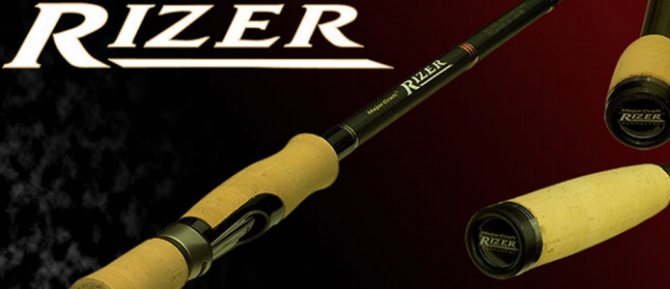
This rod is rightfully the most sensitive of this list. Of course, its casting range is slightly less than that of the first position in the rating, but the fisherman will have a better feel for how the fish catches the bait. In addition, with this fishing rod the fish is cut and reliably tied. Thus, this is no less successful fishing rod than the previous one.
The length of the rod is 2.52 m, and the weight is 8-35 g. A fast action is also used here. The weight of the bait may be slightly greater than indicated in the test, which means that the fishing rod can be used on any body of water.
Banax Thunder 90MXF2
This model is considered the most successful jig spinning rod at a low cost. Although the fishing rod has been produced for a very long time and is considered outdated, it has been tested by time and attracts more and more anglers to take up jig fishing. This spinning rod has good sensitivity, range, and excellent fishing behavior. Of course, the rod itself is flimsy, but this does not greatly affect the quality of fishing.
The length of the Banax Thunder rod is 2.74 m, which allows it to be classified as a coastal spinning rod. The recommended test is 7-25 g, but users consider these figures to be too low, since the fishing rod can easily withstand 50 g. The action here is set to medium-fast, but the fishing rod can also be equipped with an ultra-fast action.
Pontoon21 Psychogun 912MMHSF
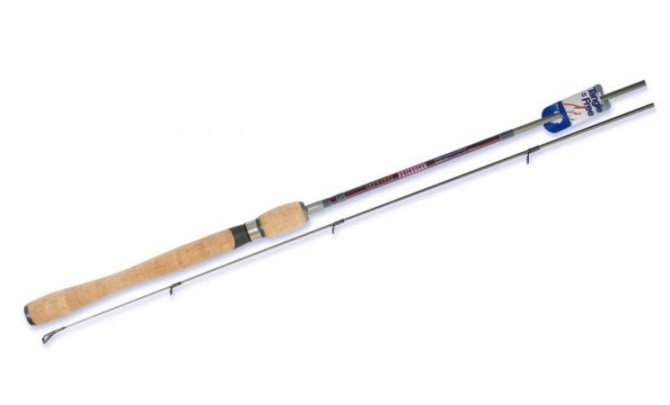
Many fishermen believe that this model is the best for jig fishing. Of course, this spinning rod has a slightly weaker range than the others, but it has maximum power. The rod is ideal for fishing in difficult conditions, when the fastest possible retrieval is required, for example, when fishing in snags.
The length of Pontoon21 is 2.74 m, and the test ranges from 10.5 to 32 g. As for the action, the manufacturers promise that they use a fast and very sensitive action. In fact, this is confirmed, since the fishing rod is well mobile, and its end produces very informative movements. This model is also called Deep Reaction, which means that it definitely belongs to spinning rods for jig fishing.
Daiko Ultimatum 962HMF
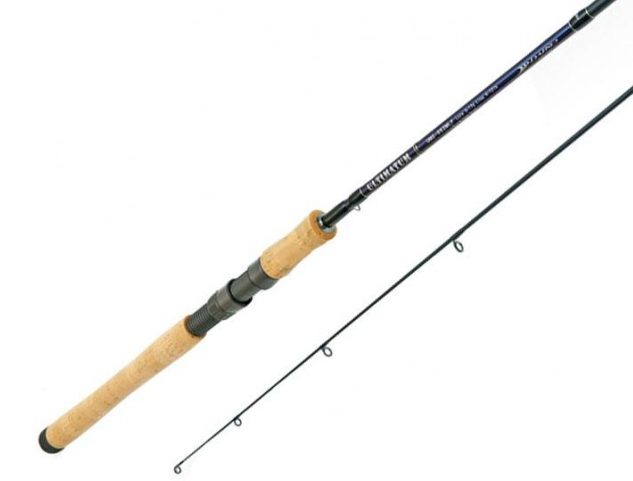
This rod allows you to use very heavy baits and is classified as a coastal spinning rod. It has the maximum bait casting range. Thus, it is easy for a fisherman to deliver bait over a distance of about 100 m. And if you install a very thin cord and a spinning reel, you can throw it over a hundred. Moreover, the fishing rod is made in such a way that even at such a long distance you can clearly see the bite.
You may be interested in: Spinning rod for trolling
The fishing rod has a length of 2.89 m. And the test is over 12 and up to 60 g. The manufacturer claims a medium-fast action.
Norstream Spiker 782MH

This model is considered a universal spinning rod for jigging, which has a budget price. The length of the rod is 2.32 m, and the test weight is 10-35 g. Thanks to these characteristics, the rod can be used both on the shore and in a boat. The spinning rod is also characterized by sufficient sensitivity, which is enough to sense minimal bites. In special cases, you can force fishing in difficult places.
Banax TinFish 80MF2
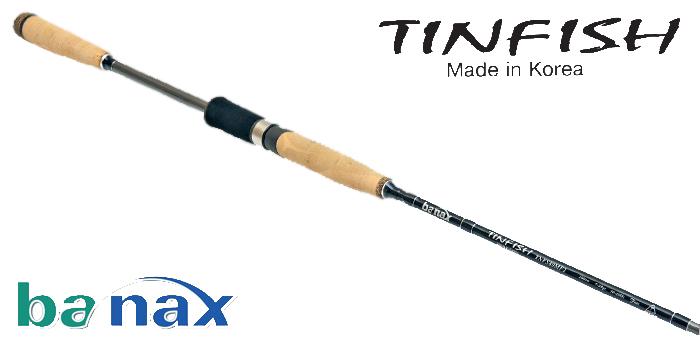
This is another versatile rod that has a long casting range and excellent sensitivity, so the fisherman feels great when fishing from the shore. As for fishing in a boat, it is ensured by a comfortable handle, minimal weight of the rod, and a length of only 2.44 m. A varied test can also be used here - 7-28 g. Sometimes you can install a heavier load. This rod is considered an ideal choice for beginners who need a universal spinning rod for jigging.
Major Craft Rizer 702H
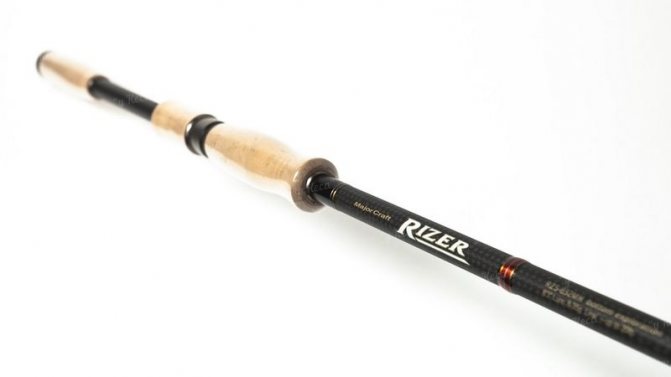
If you are looking for the perfect spinning rod for boat fishing, this model is worth considering. Yes, there are very few boat fishing rods, but among them there are worthy specimens. The length of the model is 2.13 m, and the test ranges from 10 to 42 g. It uses an ultra-fast action. A characteristic feature is the ability to use large wobblers for twitching.
Norstream Partner 70H

This is another high-quality boat spinning rod. It has a thick butt, and the rings are reinforced to ensure reliable forced playing. The rod length is only 2.13 meters, the action is super fast, and the test is 15-45 g.
GAD Harrier 702MHF

This is another great cheap spinning rod that can be used for boat fishing. It has good reliability and durability, so you can rest assured that you will be able to pull pike perch out of difficult places without any problems. The product is made with high quality, the design is thought out, and the cost is minimal.
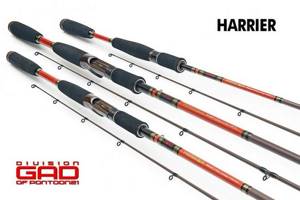
The length of the rod is 2.13 m. The rod has a fast action, the butt part is reinforced, and there is a movable tip. A spaced neoprene handle is used. Rod test - 12-45 g.
To enjoy jig fishing, you need to choose a reliable and high-quality fishing rod and other gear. With its help, you can provide the necessary wiring, notice a bite in time and cut through the fish’s mouth. Therefore, you should pay a lot of attention to the choice of such a product and take into account the recommendations of the above rating.
Jig spinning: features of choice
To make the right choice in favor of the best spinning rod for jigging, you need to decide on the fishing location: shore or boat, with a specific body of water where you will be fishing, take into account the current, depth, relief, ease of casting bait and the estimated size of future prey.
Then pay attention:
- rod length;
- I’m building it;
- test;
- material;
- configurations
A spinning rod with a blank (the blank is the basis of the spinning rod, its whip on which all other elements are attached: rings, reel) which is sensitive to bites and has good rigidity will always be an ideal option for jig fishing.
1.1.1 Form material and designation
Fiberglass or FB (fiberglass) . Rods made from this material are durable, heavy, and not very sensitive (oak). Fiberglass spinning rods are a budget option, as they are low cost and easy to use.
Carbon (carbon fiber) is a mixture of graphite and glass fiber. On the form, next to the name of the material, a rigidity indicator with a digital designation is also indicated, for example, IM-6 (intermediate modulus or conditional modulus of elasticity), a higher indicator of which indicates the rigidity and greatest sensitivity of the form, and a smaller indicator, for example, IM-1, indicates excessive flexibility.
Important! Graphite, also known as carbon, carbon fiber is an excellent conductor of electricity, so you should not use such gear during a thunderstorm, rainy weather or near electrical wires. Rods with a module from IM 4 to 6 are less capricious, but less resistant to shock and are afraid of dirt.
Advantages of this material:
- ease;
- sensitivity;
- strength.
Kevlar (artificial fiber) - carbon rods are coated with it, which gives them durability and strength.
Spinning for beginners - all the nuances
Spinning for beginners. If you want to buy a spinning rod, the simplest solution is to ask fishermen you know what they fish with and buy the same gear. But if there are no such acquaintances, you will have to decide for yourself what to buy. Of course, in a specialized store the seller will help you with advice, but...
The store will offer you only the gear that is in stock. And it is not at all necessary that only the best spinning rods, which were stored especially for you, will be available. As a rule, inexperienced people are sold what sells the worst, or what is more expensive. And only after some time you find out that such a model costs much less, or it is already an outdated model that has long been discontinued.
In addition, the variety of manufacturers of spinning rods will make you agonize over the choice. If previously all spinning rods were divided into Japanese, American, Sino-Korean and Chinese, today there are many more manufacturers. Spinning rods from the Daiwa plant have become especially widespread. Moreover, today such spinning rods are sold by all and sundry, and it is quite difficult to determine the authenticity of the origin of the gear.
Chinese spinning rods have also become more widespread, and, most interestingly, more similar to Japanese ones. Therefore, a huge selection awaits you, as well as a variety of prices.
Material for spinning rods. Let's start with an explanation - how do spinning rods differ from each other? If you buy a spinning rod that costs more than 100 rubles, then this spinning rod is made of carbon fiber. It is also called coal, carbon, graphite.
Spinning rods costing up to 1000 rubles may contain some amount of fiberglass, and this is even good, since such spinning rods are more durable and less demanding than “coal” ones. Yes, and you shouldn’t buy a carbon fiber spinning rod for 500 rubles - the first cast will leave two halves of your spinning rod.
Therefore, the presence of fiberglass is welcome, especially for novice fishermen. After all, coal spinning rods are capricious - they were placed incorrectly, thrown incorrectly, accidentally stepped on - and goodbye to the new spinning rod. But fiberglass is less capricious and will withstand such unprofessional treatment very well.
However, it is not at all easy to independently determine what spinning rods are made of. One might even say it’s unrealistic. Various stickers and inscriptions won’t help either - it might say “carbon 99%” and then... But this, in fact, is not the most important thing. As a rule, the most common question in the store is the question about the material from which the spinning rod is made.
Spinning for beginners
Only manufacturers can answer this question. We can only say one thing: many characteristics of a fishing rod depend on the elasticity coefficient of the material, and for fiberglass this coefficient is lower than for carbon fiber. But, in principle, to begin with, this does not matter much. Remember one thing: no manufacturer will indicate the elasticity coefficient on the form in numbers, and each manufacturer indicates this in its own way.
So, one company may write “IM 7” (8,9, etc.). for example, G. Loomis writes about GL2, GL3, GLX or IMX material. And comparing the characteristics of spinning rods from different manufacturers visually is a thankless task. Therefore, the main thing you should pay attention to is the cost. The higher the cost of a fishing rod, the lighter and more sensitive it is, but also the more fragile, and therefore requires professional handling.
Rings. The main thing in rings is lightness. You can, of course, be interested in the material of the ceramic insert on the ring. Particularly popular is silicon carbide “SiC”, as it is called. We can talk about branded rings, which are polished in a special way, so the casting range increases.
But in fact, everything depends on the professionalism of the fisherman. And if the rings cost more than 1000 rubles, you can be sure that you will not have any complaints about them. But let's return to the main thing - the lightness of the rings. To do this, both the “frame” and the “insert” should not be thick or bulky. The lighter the ring, the more sensitive and balanced the tackle.
Therefore, a spinning rod with 5-15 grams of dough, but with rings in a thick iron frame, is only suitable for one use - for discarding it in the trash. Not only weight, but also the number of rings plays an important role. Thus, too many guides can overload the rod, while too few guides can lead to breakage. As for expensive spinning rods, the number of rings is not important.
Ring quality. Before we deal with quality, let's figure out what the rings are actually for. Their main function is to evenly distribute the load from the fishing line along the rod blank. Therefore, pay attention that the line passes through the rings smoothly, without creating sharp corners. It is important that the rings are not sawed through by the braided line.
But today such rings are rarely found - more or less high-quality fishing rods are equipped with aluminum oxide rings. More expensive options are SIC rings (see above). But, as practice shows, there is not much difference between them. If you come across rods with suspiciously light guides, don’t be alarmed.
It’s just that these rings, with a smaller size and weight, are coated with titanium nitride, so they will cope with fishing line “excellently”, despite their low weight. The number of rings significantly affects the casting distance and the landing of fish. But manufacturers cannot come to a consensus on how many rings should be on a fishing rod, and each manufacturer praises their products.
Spinning for beginners
Moreover, the principle of placing rings on a fishing rod is a separate, rather extensive topic. Therefore, when choosing, pay attention to how well the rings are attached to the rod, whether there are any errors in the varnish coating or in the winding of the thread. The integrity of the rings is also of great importance - chips, cracks or nicks are simply unacceptable, because even the smallest notch will cut the line in a couple of seconds.
By the way, on outdated models of spinning rods, the rings are deformed when using braided fishing line. As for modern models, this practically never happens anymore. The exception is very low-quality spinning rods. And lastly: if there is a FUJI engraving on the leg of the ring, feel free to buy such a rod. The rings won't let you down, that's for sure.
Spinning. Handle and reel seat. Handle material may vary. The most common types are cork and neoprene. On expensive spinning rods, the handle is made of a material that is similar to neoprene, but is not. Although, if a spinning rod costs $200, you don’t have to worry about the handle. By the way, neoprene is now used to make handles for cheap spinning rods.
Neoprene is not inferior in strength to other materials, but it is colder, which is not always pleasant. Although it is neoprene that is used to make handles for spinning rods intended for fishing in salt water, since neoprene is insensitive to salt. For most spinning rods, a cork handle is used, and the shape of the handle can be very different.
Advice: when choosing a spinning rod, just take it in your hands and decide how comfortable it is for you to hold it. And take a closer look at how tightly the handle fits to the form - if there are gaps and cavities, this indicates poor quality of gluing. And this will lead to the destruction of the handle very soon.
Reel seats can have different designs. At the same time, the reel you are going to use may not always fit the reel seat. Therefore, when purchasing a reel seat, take the reel with you and try it on a spinning rod. As practice shows, many cases of returning spinning rods occurred precisely because of the incompatibility of the reel and reel seat.
Spinning rod length. On average, the normal length of a spinning rod is 2-3 meters. If you are buying your first spinning rod, choose a rod 2.4-2.7 meters long, this is the best option for you. If you prefer fishing from the shore on a large body of water, purchase a 3-meter long rod. But for small rivers you should not take a spinning rod longer than two meters.
The length of the rod affects the casting distance, the movement of the spinning rod across the pond, the quality of fishing, and how quickly you get tired. Therefore, for fishing from the shore, buy long rods (unless, of course, you are fishing on the bank of a narrow river). These rods are also great for fishing from a boat.
Spinning for beginners
As for short spinning rods, it has only one advantage - mobility and compactness. Of course, the length of the spinning rod is selected depending on the type of fishing. Rods with a length of 2.4-2.7 meters can be called universal. Spinning rods with a longer or shorter length are more special, designed for a specific type of fishing and a specific type of reservoir.
If the length on the rod is indicated not in meters, but in feet, you simply multiply the indicated figure by 30cm (approximately). The result is the length in meters, plus a couple of centimeters. It is much easier to choose a spinning rod if you know where you will be fishing (from a boat or from the shore) and what body of water your fishing will be on. For fishing from a boat, choose a spinning rod up to 2.4 m; such a spinning rod is easier to handle.
For fishing from the shore, it is better to choose a spinning rod with a length of 2.7 meters. If you are going to fish both from a boat and from the shore, buy a rod 2.3-2.6 meters long. Although it would be more successful to purchase two spinning rods - separately for fishing from a boat and separately for fishing from the shore.
Test, build. Many people confuse parameters such as test, power and tuning. For a spinning rod, the main thing is small test, high power, and the system can be whatever you want. The test is selected according to the bait, or more precisely, according to its weight. For example, for a 5-10 gram spinner we select the 5-20 test. For a jig weighing 30-40 grams, select a test slightly higher than the heaviest load.
But there is a difficulty - the stated test may not correspond to the real one. How to determine? On expensive spinning rods the test is most likely true, but on cheaper ones it is unlikely. In a word, those spinning rods that cost from 200 USD can be bought “with your eyes closed”, the main thing is that the test and length are suitable.
Test – set by the manufacturer. Typically, the test is written on a form next to the handle, for example, “10-20gr”. It is better to purchase a spinning rod with a dough of 2-25g, plus/minus small deviations. At the same time, 5 is for a regular spinner, and 25 is for a jig head (for fishing in reservoirs with large currents and great depth). Any baits are placed between these values.
Action is the degree of bending of the rod when casting or retrieving fish. The system can be of three types: slow, medium, fast. Fast action: only the tip of the rod bends. Slow action - the rod bends completely. The average system is just that - average. A spinning rod with a fast action is suitable for precise casting and sharp hooking.
In addition, a fast action is more sensitive to bites. A slow action is better suited for long casting and smooth fishing, as such a rod smoothes out the jerks of the fish. How to find out what action a given rod has? Ask the seller to hold the tip of the spinning rod and pull the spinning rod up. By the way the rod bends you can determine its action.
By the way, such a demonstration is often used by sellers to demonstrate the strength of a fishing rod. But today almost all spinning rods can bend into an arc. But if you managed to bend the rod like this, you can easily catch even large fish. Among the Japanese-made models, there are also those that can bend all the way to the handle.
Spinning for beginners
Impressive, but it’s better not to do this on other rods. Which system to choose depends on your preferences and needs. Moreover, both the test and the system are, one might say, subjective concepts. For middle-class spinning rods, the lure test is indicated in grams or ounces. For good performance of the rod, it is important that the weight of the bait matches the range indicated on the rod.
But. For spinners and wobblers weighing 10 grams, a spinning rod with a test of 3-12 is not suitable, since the resistance of the bait when retrieving must be taken into account. Therefore, a spinner, and a wobbler too, which weighs less than 10 grams can strongly bend a rod with a test of 3-12. Therefore, fishing with such bait and such a rod will not be comfortable, to put it mildly. The situation is completely different with fishing in the toad field.
Light lures require a strong rod to prevent the fish from getting too free. So, when choosing a test, you should pay attention not only to the weight of the bait, but also to other aspects. By the way, on expensive fishing rods the line test is also indicated, that is, the range of line strength that is suitable for a given spinning rod. As for power, it is relevant for expensive spinning rods, so we’ll talk about it another time.
Sensitivity. The sensitivity of a fishing rod is a combination of the properties of the material, action, test, and rings. In other words, sensitivity is a set of basic parameters. Sensitivity is important even for beginners, and not just for identifying bites when fishing with a jig.
So, if you attach a weight with a weight of 100 g to a spinning rod with a dough of 5-25 g, your fishing will end there - your spinning rod will not even notice a small fish, and what can we say about fishing. If you follow this example, then the best spinning rod will turn out to be a damaged tackle if you put the wrong rings on it.
After all, a spinning rod is a rather complex structure, having different tapers and different wall thicknesses of the blank. The material in different parts and layers of the spinning rod may also differ. Of course, you need to fish for more than one year, and with more than one spinning rod, to feel confident in the store; reading about it is not enough.
But there are two sensitivity parameters that you can determine yourself - the mass of the rod and its speed of returning the spinning rod to its original position after losing balance. The weight of the rod is determined simply by hand - a heavier rod lies comfortably in the hand, due to the distribution of mass along the length.
Spinning for beginners
The lighter the rod, the higher its sensitivity. As for the second parameter, this is the time during which the tip of the spinning rod stops twitching after you shake it. The shorter this time, the better. The term sensitivity is easy to understand for those who have fished with different rods. To put it simply, sensitivity is the ability of a rod to transmit information about the state of the bait.
A sensitive rod will let you know whether the bait has touched the bottom, or a bite has begun, grass has wound around the spoon, or the fish is already on the hook. The degree of sensitivity depends on the material from which the spinning rod is made. But for a beginner, it is almost impossible to understand and determine how sensitive a rod is - everything comes with experience, and everything is learned by comparison.
Tips for beginners. For those who do not have experience in fishing and do not know clearly where and what they will catch, the best option would be a spinning rod 2.1 meters long, of an average price category, with a dough of 10-30g. This fishing rod will not break and is suitable for any bait. For those who prefer to fish on lakes (pike, for example), you need a more expensive spinning rod, costing from $50.
Spinning rod length – 2.4-2.7 meters, test – 20-25g. For those who want to fish with a rubber band, a spinning rod 3 meters long, with a dough of 15-40g, is suitable. The price of such a spinning rod should be at least $70. For those who want a universal spinning rod for fishing in different bodies of water, a rod 2.7 meters long, with a test weight of 5-25, or 10-30g, is suitable.
This spinning rod is suitable for fishing from a boat and for fishing from the shore, with any bait. Spinning “just in case.” An inexpensive spinning rod is suitable, preferably a telescopic one, costing about 1000 rubles. The rod is composite.
Price. For beginners and inexperienced anglers, we recommend purchasing an inexpensive fishing rod. If it breaks, it’s not a pity, but as long as you study, such cases will be frequent. Therefore, spinning rods with a price of 2000-3000 rubles are suitable for you. After you gain experience and get comfortable, you can purchase a more expensive model, but up to 3,000 rubles.
As for expensive models, their price ranges from $200 and above. But such models are for professionals, and a beginner will not be able to appreciate all their advantages. And if you have extra money, buy good fishing line and bait.
1.3.1 Spinning rod length for shore fishing
The optimal length for fishing from the shore is from 2.4 to 2.7 m with a test of 35-40 g. With more weight, it is harder to reel and snags cannot be avoided. Heavy baits will be effective when fishing in holes and strong currents. It is better to purchase a spinning rod made of carbon fiber marked IM6, IM7, IM8 and more or carbon material. Lure weight = spinning class.
For example, to catch catfish in thickets and strong currents, you need to use hard tackle and bait weighing 40 - 120 grams. For fishing in still water, it is enough to use tackle with a test from 10 to 40 g (for example, a medium action plug daiwa sweepfire SW802LFS-BD jigger 2.4 m, test 5-25 g).
A universal spinning rod model that is suitable for fishing in standing waters from the shore or from a boat, as well as on all types of rivers - with a length from 1.8 to 2.4 m, a medium class action, a test in the range of 10-40 g. An example is the Daiwa “Sweepfire” SW802LFS-BD jigger 2.4 m plug with 5-25 g test and medium action.
How to choose a spinning rod for jig
Recently, a fishing method that has gained popularity is the jig method.
This fishing is now very common. The gear for it is relatively inexpensive, and there are no special difficulties either. Retrieving the bait for this type of fishing is a stepped retrieve. The industry produces a large number of all kinds of jig heads. Rubber crustaceans, twisters, and vibrating tails are mounted on them. The essence of this fishing is based on the fact that after casting the bait over a certain distance, you need to twitch with the rod and the choice of fishing line so that the bait makes jumps, imitating a wounded fish.
Fishing itself using the jig method is the most successful method of catching predators in the pre-spawning and post-spawning periods, during feeding hours. In terms of production, this method is slightly inferior to trolling. But for successful fishing you need to choose gear and appropriate bait. A spinning rod for jig must accurately cast the jig head, transfer all its movements to the angler’s hand and ensure that the catch is caught.
It should be noted here that jig heads have different weights. Therefore, there are some requirements for spinning rods that are sometimes incomprehensible to the fisherman.
To successfully fish with a spinning rod, you need to know about the features of its individual parts:
The rod is the basis of everything. Constructed from a whip, a handle, guide rings and a clamp for attaching a reel. Every element is important. With the help of a rod, the bait is cast, hooked and the fish itself is landed.
A fishing rod must have such incompatible characteristics as strength and lightness, elasticity and flexibility, hardness and softness. They are made from fiberglass, carbon fiber, and add boron-containing fibers from a multilayer composite. In terms of material, a jig spinning rod does not differ from a regular one, but composite rods based on carbon fiber are considered optimal.
According to their design, these fishing rods are divided into solid, all-component, telescopic, plug, and picker. For catching perch with jigs, picker baits are suitable; for larger predators, plug and telescopic ones are suitable. You should not take all-component ones due to poor flexibility.
How to choose a spinning rod for jig fishing, see:
What test is needed for jig fishing?
According to the weight (test) of the bait used, spinning rods are divided into:
| Lightest class (ultralight) | bait weighing up to 10 grams |
| Light class (light) | bait weighing up to 20 grams |
| Middle class (medium) | bait weighing up to 40 grams |
| Heavy class (heavy) | bait weighing up to 100 grams |
| Super heavy (extra heavy) | bait weight from 120 grams |
The test of a rod is usually marked at the handle and is sometimes stated in ounces.
1 ounce – 28 gr. To determine the action of the rod, you need to take it in your hand and use your hand to jerk the whip into motion. And if the whole rod trembles, then its action will be soft. And vice versa, if only the top, then the system should be considered rigid.
This is the most important indicator when buying a spinning rod. If you choose the wrong rod action, you can also jig with it. True, whether there will be success in this is the question. It is impossible to spin with a rod test that is not suitable for the fishing conditions.
For example, on a large body of water with a strong current you need a heavy class with a dough of 40 grams or . And to catch perch in calm water, you need the lightest, or light class with a weight of up to 20 grams. In shallow water it is suitable even with a dough of 5 grams or more. For beginner fishermen who do not know how to send bait far and accurately, a spinning rod with a weight of 40 grams is suitable.
Build

One of the most important characteristics of a fishing rod is its structure , which means deformation resistance.
They are divided into three types:
- Spinning action slow
Rigid (narrow parabolic action) Extra fast – they do not spring well, do not cast the bait far, do not signal the play of the spinner in the angler’s hand; - Medium-hard (parabolic action) Moderate – universal, used for catching any fish;
- Soft (widely parabolic action) Slow - they are not suitable for casting relatively heavy baits.
The letters are also written on the whip itself: EF (Extra Fast) - only the tip of the rod itself will bend, F (Fast) - the upper third will bend, (M) moderate - half of the rod will bend.
This means that spinning rods with fast and very fast action are better for jig fishing.
The structure of the rod itself is determined by its flexibility and speed of response to a bite. When the upper tip is bent, the tuning is also called “end”.
The most common is the universal “parabolic” . The choice of fishing rod for this indicator depends on the fishing location and the habits of the fisherman himself. With a slow action it is good to make long casts on a decent body of water, and a fast action is more sensitive to bites and transmission of signals from the bait to the angler’s hand.
It should also be noted that an excellent rod for jigging is a plug rod. This connection allows you to better feel the entire tackle.
Weight, length
These two characteristics depend on the fishing conditions and on the angler himself.
The most common spinning rod will have a length of 3.6-3.8 meters. Not all rivers have much vegetation, so these characteristics may be suitable. Only if it is made of fiberglass, it will be problematic to hold it for a long time. Light spinning rods are used on narrow and small rivers, tying baits of 6-10 grams to it. The length is determined depending on the fishing location. Jigging with a spinning rod 3.0–3.8 meters long on a river 3-5 meters wide is much more difficult than with a tackle length of 1.8–2.4 meters.
From a boat, a length of up to 2.4 meters .
Choice depending on fishing conditions
In this matter, you don’t have to accept everything completely; you will never find the ideal option.
A jig rod is a completely reasonable compromise. You will never determine that this spinning rod can only be suitable for jigging, but this one is not. It should be suitable for the selected fishing area and be comfortable for the angler. The success of fishing with a spinning rod is determined by the work of the bait itself, from the correct wiring and from the shape and color of the bait. The fish doesn’t care what bait is served to it. But the fisherman cares. Jig fishing itself involves active movement near the water and active hand work. It is clear that if the tackle is heavy and uncomfortable, then there will be no effect from such fishing.
One of the typical mistakes of spinning anglers is to fish remote areas first. And the fish can be literally at the angler’s feet. It is more correct to process the coastal zone first, and only then move on to a remote area.
When jigging on small rivers and reservoirs , it is recommended to use a light and short (1.8-2.4 m) rod and a fishing line of no more than 0.2 mm. By the way, there is no need to use heavy primaks in such conditions - they will be of no use, they simply will not have time to “play out”. By the way, to use them you need a rigid rod.
Rod rigging tips
A spinning reel can be used provided that a bait weighing 15 grams or less is used; for larger weights it is better to use a multiplier. So, for a shallow reservoir, a soap dish or low-profile reel is suitable. For jig fishing with a bait weight of up to 28 grams, a monofilament line with a diameter of 0.32 mm is selected.
Read the most detailed information about monofilament fishing line, its characteristics, installation methods, storage and care here
For a small pool but with a strong current, it is better to install a barrel-shaped reel, which will perform well when fishing with bait weighing up to 60 grams.
If you use a weight of up to 8 grams, then take a reel of size 1000-2000, up to 16 grams - 2500-3000, and up to 30 grams - 3500. These reels are of the high-speed type, which ensures fast winding of the fishing line (cord).
According to most anglers, it is better to use braided line for jig fishing, which allows you to feel the bait, help you study the bottom, and ensure casting range.
Do you need a breakaway leash? Its use is recommended when fishing with small baits in medium and small currents and in the presence of an edge.
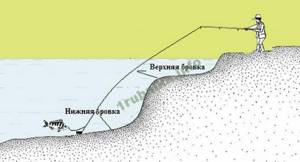
The optimal length of the lead leash for jig fishing is 12 cm.
Read everything you didn’t know about the retractable leash here
Features of the spinning rod design
4.1 Form design
Spinning rods can have a solid form (single-part), 2-3-part, telescopic. The advantage of one-part is sensitivity. The downside is the length of the gear, which is not convenient for transportation. The telescopic tackle is easy to transport, but lacks sensitivity.
Thus, the 2nd private owner considers the most suitable form.
4.2 Rings
It is also necessary to pay attention to this design feature of the spin, since bad guides quickly wear out the fishing line and affect its flight when casting the bait.
4.3 Spinning rod handle
It can be either cork or polyurethane foam. We consider them to be of equal quality. Each spinning player chooses one or another material according to his wishes.
